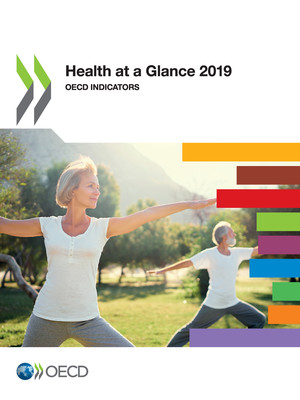copy the linklink copied!Opioids use
Opioids are a narcotic pain medication that have become the cornerstone therapy for treatment of moderate to severe pain in many high-income countries. In parallel, illicit opioid use for nonmedical purposes has created illegal, increasingly commercialised global markets. Canada and the United States have experienced an opioid crisis in recent years, fuelled by growth in the consumption of synthetic opioids such as fentanyl and carfentanil. Problematic opioid use is also spreading in Australia and some European countries, due to growing prescription rates (see indicator on “Safe primary care – prescribing” in Chapter 6) and the development of a dynamic illegal drug supply market (OECD, 2019[1]).
For prescription opioids, whilst there is insufficient access in many low- and middle-income countries, the reality in OECD countries is quite different, where the availability of analgesic opioids has been steadily growing. The United States has the highest availability of analgesic opioids among OECD countries, followed by Germany and Canada, while Mexico, Chile and Colombia show the lowest numbers. The sharpest increases occurred in the 2000s: between 2002-04 and 2005-07 analgesic opioids availability grew on average by 59% and over the decade by almost 110%. More recently, the growth rate dropped to 5.4% on average between 2011-13 and 2014-16. In absolute terms, availability per person increased the most in Israel, the United Kingdom, Germany; the sharpest falls were in the United States, Denmark and Luxembourg (Figure 4.6).
Opioid-related deaths is a key indicator that reflects the impact of problematic use of the drug, both of legally prescribed drugs and illegal drugs (e.g. heroin). On average across 25 OECD countries for which data are available, there were 26 opioid-related deaths per million inhabitants in 2016 (Figure 4.7). However, death rates were over five times higher in the United States (131 opioid-related deaths), followed closely by Canada (120). Opioid-related deaths have increased by about 20% since 2011, with large increases in the United States, Sweden, Canada, England and Wales, and Lithuania. In the United States, almost 400 000 people died from an opioid overdose between 1999 and 2017, with the opioid crisis contributing to the first decline in life expectancy observed in over half a century.
Countries are implementing several strategies to address the problematic use of opioids, with comprehensive approaches across different sectors, covering health, social services, law enforcement, data systems and research. Countries have aimed to improve opioid prescribing through evidence-based clinical guidelines, training, surveillance of opioid prescriptions, and regulation of marketing and financial relationships with opioid manufacturers. Educational materials and awareness interventions have been developed for both at-risk patients and the general public. For patients with opioid use disorder, there has been increased coverage for long-term medication-assisted therapy combined with specialised services for infectious diseases and psychosocial interventions. Many countries have also implemented harm minimisation interventions such as overdose reversal medications, needle and syringe programmes and medically supervised consumptions centres. Research initiatives to boost innovation in pain relief and opioid use disorders treatments have also been launched (OECD, 2019[1]).
Availability of analgesic opioid is defined as amounts that each country's competent national authority estimates are needed and used annually, including reporting of medicines destroyed, losses during manufacture, etc. This information is verified by the International Narcotics Control Board using data from export and import notifications. The S-DDD is a technical unit of measurement. It is not a recommended prescription dose. It recognises that no internationally agreed standard doses exist for opioid medicines and therefore provides a rough measure to rank opioid use of countries. Levels of use, expressed in S-DDD per million inhabitants per day, are calculated with the following formula: annual use divided by 365 days, divided by the population in millions of the country or territory during the year, divided by the defined daily dose (Berterame et al., 2016[2]). Analgesic opioids include codeine, dextropropoxyphene, dihydrocodeine, fentanyl, hydrocodone, hydromorphone, morphine, ketobemidone, oxycodone, pethidine, tilidine and trimeperidine. It does not include illicit opioids. Those data do not directly reflect the consumption of analgesic opioids in countries, but the general availability for different purposes, of which the largest component is for medical use.
Opioid-related deaths for European countries are collected and shared with the OECD by the European Monitoring Centre for Drugs and Drug Addiction (EMCDDA). This was complemented with data contributed directly from countries to the OECD using an adapted version of the EMCDDA’s data questionnaire.
References
[2] Berterame, S. et al. (2016), “Use of and barriers to access to opioid analgesics: a worldwide, regional, and national study”, The Lancet, Vol. 387/10028, pp. 1644-1656, https://doi.org/10.1016/S0140-6736(16)00161-6.
[1] OECD (2019), Addressing Problematic Opioid Use in OECD Countries, OECD Health Policy Studies, OECD Publishing, Paris, https://dx.doi.org/10.1787/a18286f0-en.




